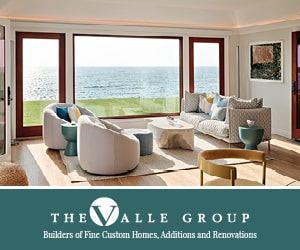
A Grand Synergy
Cape Cod Home / Spring 2014 / Art & Entertainment, Home, Garden & Design, People & Businesses
Writer: Laurel Kornhiser / Photographer: Brian Vanden Brink
A Grand Synergy

Cape Cod Home / Spring 2014 / Art & Entertainment, Home, Garden & Design, People & Businesses
Writer: Laurel Kornhiser / Photographer: Brian Vanden Brink
A Pleasant Bay home combines the best of nature with Polhemus Savery DaSilva’s architectural innovation, creating a showcase for the homeowners’ art and furniture collections—and a cherished retreat for their family
There is nature’s art, and then there are human creations. Nature favors curves, variety, ever shifting views, light and shade. Enhancing and working with natural elements, humans imitate, configure, and arrange nature’s wonders to please and surprise the eye. With architecture, an ideal situation occurs when professionals work with nature to create a design that embraces the scene nature has set while realizing and celebrating the works of the human imagination.
This was just the case when architect John DaSilva and the design and construction team of Polhemus Savery DaSilva Architects Builders of Chatham collaborated with open-minded clients from New York to design and build a family-friendly home that sits comfortably on a wooded knoll while offering varied frames for views of a marsh, Pleasant Bay, and the ocean beyond. With grand human-nature synergy, the home also acts as a gallery for the couple’s art and art furniture collections.
Having already lived in a traditional expanded Cape-style home in Chatham, the couple was seeking something a little bit different this time, with inspiration coming from the American West and other areas of New England. “We had seen a lot of beautiful homes, particularly lake homes, while traveling in upstate New Hampshire and Vermont,” says the wife. This is not to suggest that their Cape home is out of synch with its local setting. Gothic Revival windows, broadly gabled shingle styling, and arts and crafts detailing all have precedents on the Cape and Islands. This melding and updating of traditional styles was, in fact, an aspect of the project that gave DaSilva great joy. “To have the opportunity to design a house that is clearly contemporary, but synthesizes eclectic influences from both the regional context and architectural history is very gratifying. I am quite proud of the results,” says the architect.
The home is barely visible from the water and is discovered as a series of surprises from the wooded side. Approached up a sweeping drive, the home’s front façade reveals nature’s influence. A steep sloping roof with a triptych of dormers rising from behind suggests a range of mountain peaks. The tracery in five Gothic arches and large overhangs recalls, as DaSilva says, “The sheltering canopy of the surrounding trees.” In the soaring chimney, a pebbledash glass panel, which is an update of a shingle-style detail, captures the ever-changing colors of the nearby marsh at sunset. “When the light hits it, it is like a living painting,” the homeowner says. Donna Mahan of Truro executed the panel, based on a design by DaSilva’s wife, architect Sharon DaSilva, using epoxy, pebbles, and glass chunks.
Reflecting the varied natural terrain around it, the home’s exterior presents many intriguing elements, including a porte-cochere leading under five Gothic arches to a motor court and three garages and Victorian-inspired swirled brackets holding up those arches. Between the screen wall created by the arches and a large round window is an opening to the sky. Beyond the port-cochere, the building extends out toward the trees and evokes, DaSilva suggests, the motion of a moving train. Secluded in this special space is the wife’s art studio, where, when time allows, she retreats to paint. Her husband often sits nearby tying flies, playing guitar, or listening to music.
Inside the home, art, architecture, and nature collaborate in every space. Outdoor architectural elements are echoed: plaster soffits and brackets form the boundary between the dining room and adjacent kitchen and family areas. Stair balusters and railings bring to mind the outside arches. Three sets of brackets, like those outside, delineate an upper gallery, which occupies the space gained above the porte-cochere.
A soaring stone fireplace—one of five fireplaces in the home—defines the entryway. Drawing the eye upward, it shows off not only a gallery-level cutout, currently occupied by a stone owl, but leads the eye to a ceiling from which a Poulsen Artichoke Pendant light hangs, an object DaSilva recommended: “It has the eclectic feeling of being contemporary, but still full of evocative character like the rest of the house,” he explains.
The couple collects paintings by artists like Paul Resika, Mercedes Matter, and Alexander Calder; pieces by Louis Comfort Tiffany, as well as pottery and Italian glass which are displayed on internally lit pedestals in the second-floor gallery. Additional art is displayed on custom shelving in the living room and throughout the home.

Photography by Brian Vanden Brink
The home’s furniture also makes a statement. Art furniture pieces, such as the living room coffee table, the side tables in the sunroom, and the master bed headboard are from Pritam & Eames on Long Island, New York.
While the house acts as a frame and backdrop for art, it is also built for people, including the couple’s two daughters and grandchildren. “It’s a livable house,” says the husband. “We built the house for family.”
Human art is well accommodated by the home, but so are nature’s displays. The T-shaped house was designed to absorb the views from various angles and through various frames. The living spaces on the first floor, and the second floor master bedroom, and three guest rooms all face the views. Each position and each window offer a slightly different version of the seascape: “There is so much view,” says DaSilva, “that putting in grids, columns, and arches and such, frames and highlights the view without diminishing it.”
All of the water views are to the north, which made the maximization of light from the south one of the major challenges of the project. To that end, DaSilva says, the architects used south-facing, high clerestory windows and dormers set with triangular windows. A deck carved out of the roof and accessed from the top of the broad curving staircase sheds light into the core of the home, as does the generous entry hall, which captures southern light and sends it toward the north facing living areas.
While the home’s interiors are captivating enough to keep everyone inside, the family loves the many diversions the Cape offers. In addition to fishing, the couple enjoys boating and skeet shooting. They also like to picnic on the outer beach and watch for whales off the coast.
After a busy day spent outdoors, however, the couple likes to retreat to what they call the “jewel box” and DaSilva calls a “woodland chapel.” It is the sunroom, where they are as likely to begin as end their day, reading, listening to music, absorbing the views, and admiring the naturalistic landscape, designed by Hawk Landscape Design of Sagamore Beach. The wife says their astute 6-year-old grandson asked why the room has only two chairs. “We do need our privacy,” the husband comments.
Nature has inspired many of this home’s elements, and human imagination has created the rest, making a home of living art. The picture is dynamic, captivating, full of surprises, and beautiful to behold.




